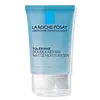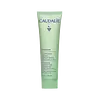What's inside
What's inside
 Key Ingredients
Key Ingredients

 Benefits
Benefits

 Concerns
Concerns

 Ingredients Side-by-side
Ingredients Side-by-side

Water
Skin ConditioningGlycerin
HumectantSilica
AbrasiveBetaine
HumectantNiacinamide
SmoothingCetearyl Isononanoate
EmollientZea Mays Starch
AbsorbentCeramide NP
Skin ConditioningCarbomer
Emulsion StabilisingGlyceryl Stearate Citrate
EmollientSodium Hyaluronate
HumectantSodium Hydroxide
BufferingPerlite
AbsorbentHydroxyacetophenone
AntioxidantCaprylyl Glycol
EmollientXanthan Gum
EmulsifyingWater
Skin ConditioningButylene Glycol
HumectantCoco-Caprylate/Caprate
EmollientVitis Vinifera Fruit Water
Skin ConditioningSilica
AbrasiveSqualane
EmollientGlycerin
HumectantTapioca Starch
Glyceryl Stearate
EmollientIsostearyl Isostearate
EmollientPalmitoyl Grape Seed Extract
Skin ConditioningAlcohol Denat.
AntimicrobialAcrylates/C10-30 Alkyl Acrylate Crosspolymer
Emulsion StabilisingCaprylyl Glycol
EmollientXanthan Gum
EmulsifyingEnantia Chlorantha Bark Extract
Skin ConditioningPentylene Glycol
Skin ConditioningPotassium Cetyl Phosphate
EmulsifyingVitis Vinifera Juice
AntioxidantTocopherol
AntioxidantHelianthus Annuus Seed Oil
EmollientSodium Phytate
Citric Acid
BufferingPelargonium Graveolens Flower Oil
MaskingSodium Hydroxide
BufferingSodium Carboxymethyl Beta-Glucan
CleansingMentha Piperita Oil
MaskingCitral
PerfumingCymbopogon Citratus Leaf Oil
MaskingSodium Benzoate
MaskingRosmarinus Officinalis Leaf Oil
MaskingCitronellol
PerfumingMaltodextrin
AbsorbentOrthosiphon Stamineus Extract
Skin ConditioningPotassium Sorbate
PreservativeLavandula Hybrida Oil
EmollientMelissa Officinalis Leaf Oil
MaskingOleanolic Acid
Skin ConditioningGeraniol
PerfumingLinalool
PerfumingLimonene
PerfumingWater, Butylene Glycol, Coco-Caprylate/Caprate, Vitis Vinifera Fruit Water, Silica, Squalane, Glycerin, Tapioca Starch, Glyceryl Stearate, Isostearyl Isostearate, Palmitoyl Grape Seed Extract, Alcohol Denat., Acrylates/C10-30 Alkyl Acrylate Crosspolymer, Caprylyl Glycol, Xanthan Gum, Enantia Chlorantha Bark Extract, Pentylene Glycol, Potassium Cetyl Phosphate, Vitis Vinifera Juice, Tocopherol, Helianthus Annuus Seed Oil, Sodium Phytate, Citric Acid, Pelargonium Graveolens Flower Oil, Sodium Hydroxide, Sodium Carboxymethyl Beta-Glucan, Mentha Piperita Oil, Citral, Cymbopogon Citratus Leaf Oil, Sodium Benzoate, Rosmarinus Officinalis Leaf Oil, Citronellol, Maltodextrin, Orthosiphon Stamineus Extract, Potassium Sorbate, Lavandula Hybrida Oil, Melissa Officinalis Leaf Oil, Oleanolic Acid, Geraniol, Linalool, Limonene
 Reviews
Reviews

Ingredients Explained
These ingredients are found in both products.
Ingredients higher up in an ingredient list are typically present in a larger amount.
Caprylyl Glycol is a humectant and emollient, meaning it attracts and preserves moisture.
It is a common ingredient in many products, especially those designed to hydrate skin. The primary benefits are retaining moisture, skin softening, and promoting a healthy skin barrier.
Though Caprylyl Glycol is an alcohol derived from fatty acids, it is not the kind that can dry out skin.
This ingredient is also used as a preservative to extend the life of products. It has slight antimicrobial properties.
Learn more about Caprylyl GlycolGlycerin is already naturally found in your skin. It helps moisturize and protect your skin.
A study from 2016 found glycerin to be more effective as a humectant than AHAs and hyaluronic acid.
As a humectant, it helps the skin stay hydrated by pulling moisture to your skin. The low molecular weight of glycerin allows it to pull moisture into the deeper layers of your skin.
Hydrated skin improves your skin barrier; Your skin barrier helps protect against irritants and bacteria.
Glycerin has also been found to have antimicrobial and antiviral properties. Due to these properties, glycerin is often used in wound and burn treatments.
In cosmetics, glycerin is usually derived from plants such as soybean or palm. However, it can also be sourced from animals, such as tallow or animal fat.
This ingredient is organic, colorless, odorless, and non-toxic.
Glycerin is the name for this ingredient in American English. British English uses Glycerol/Glycerine.
Learn more about GlycerinSilica, also known as silicon dioxide, is a naturally occurring mineral. It is used as a fine, spherical, and porous powder in cosmetics.
Though it has exfoliant properties, the function of silica varies depending on the product.
The unique structure of silica enhances the spreadability and adds smoothness, making it a great texture enhancer.
It is also used as an active carrier, emulsifier, and mattifier due to its ability to absorb excess oil.
In some products, tiny microneedles called spicules are made from silica or hydrolyzed sponge. When you rub them in, they lightly polish away dead skin layers and enhance the penetration of active ingredients.
Learn more about SilicaSodium Hydroxide is also known as lye or caustic soda. It is used to adjust the pH of products; many ingredients require a specific pH to be effective.
In small amounts, sodium hydroxide is considered safe to use. However, large amounts may cause chemical burns due to its high alkaline.
Your skin has a natural pH and acid mantle. This acid mantle helps prevent harmful bacteria from breaking through. The acid mantle also helps keep your skin hydrated.
"Alkaline" refers to a high pH level. A low pH level would be considered acidic.
Learn more about Sodium HydroxideWater. It's the most common cosmetic ingredient of all. You'll usually see it at the top of ingredient lists, meaning that it makes up the largest part of the product.
So why is it so popular? Water most often acts as a solvent - this means that it helps dissolve other ingredients into the formulation.
You'll also recognize water as that liquid we all need to stay alive. If you see this, drink a glass of water. Stay hydrated!
Learn more about WaterXanthan gum is used as a stabilizer and thickener within cosmetic products. It helps give products a sticky, thick feeling - preventing them from being too runny.
On the technical side of things, xanthan gum is a polysaccharide - a combination consisting of multiple sugar molecules bonded together.
Xanthan gum is a pretty common and great ingredient. It is a natural, non-toxic, non-irritating ingredient that is also commonly used in food products.
Learn more about Xanthan Gum